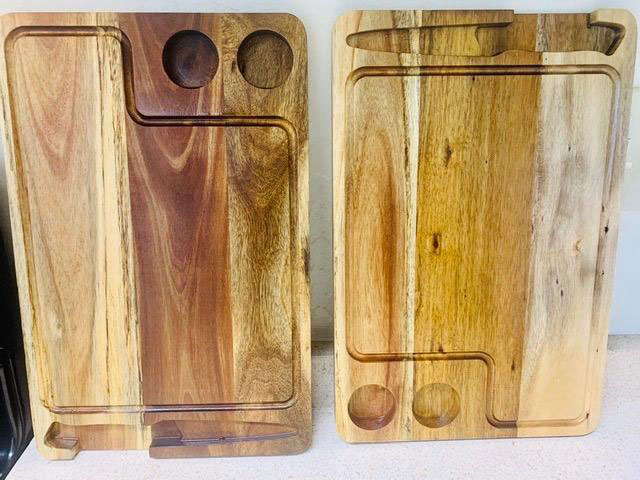A wooden cutting board is a staple in any kitchen, but it requires proper care and maintenance to ensure its longevity and safety for food preparation. One of the most important aspects of maintaining a wooden cutting board is oiling it regularly to protect and nourish the wood. However, with so many different types of oil available, choosing the best oil for wood-cutting boards can be a challenging task.
Which is the best wood for end grain cutting board?
From classic mineral oil to natural oils like coconut and walnut, each type of oil has different unique properties that can affect the performance and appearance of your cutting board. [1]
So, what oil to use on cutting boards?
Let’s explore the world of oils and find out.
4 Types of Oil for Wooden Boards/Sheets
1. Mineral Oil
This is a popular choice for cutting board oil because it is food-safe, inexpensive, and easy to find. It is a petroleum-based product that does not go rancid like other oils, and it is also odorless and tasteless. So, if you don’t want to contaminate your cutting board with harmful chemicals or additives, mineral oil is the ideal choice.
Mineral oil is relatively inexpensive compared to other cutting board oils, making it an affordable option for those on a budget. Moreover, mineral oil is a hydrophobic oil, meaning it repels water and moisture. This helps to prevent the wood from absorbing water, which can cause warping or cracking. It is also very easy to apply to wood-cutting boards. Simply apply a thin layer of oil to the board and allow it to soak in for several hours or overnight.
Overall, mineral oil is an excellent oil for cutting boards, but it is not very durable and thus not suitable for high-use cutting boards that require maximum protection. Because mineral oil is not as durable as other oils, it may need to be reapplied more frequently to maintain its protective properties. If it’s applied too much it can easily leave oil residue on the board which as result can attract dirt and debris and also make food preparation difficult.
2. Coconut Oil
Coconut oil is another excellent wood cutting board oil with antimicrobial properties and a pleasant smell, which can hardly be found in any other cutting board mineral oil. It contains lauric acid, which fights bacteria and fungi on your cutting board and keeps it safe and clean. While the tropical scent can leave your cutting board smelling fresh and make your cutting experience more enjoyable.
Unlike other oils such as Beeswax and mineral oil for cutting boards, coconut oil is a rich source of fatty acids that can penetrate the wood and help to moisturize and condition it. Consequently, you can easily use it on high-use cutting boards and don’t need to apply it more frequently. Also, coconut oil is food grade and highly inexpensive, making it ideal for those who are looking for a budget option.
The only drawback we found in coconut oil is that coconut oil can become rancid over time if not stored properly. This can cause an unpleasant odor and taste and may even lead to bacterial growth on the cutting board. Also, it can be messy to apply, especially if it is solid at room temperature, and can leave a greasy residue on the cutting board, which may be difficult to clean off.
3. Beeswax
Beeswax is also an excellent choice for wood-cutting boards because of its natural properties that help protect and preserve the wood. It is food-safe and creates a natural barrier on the surface of the wood that helps protect it from moisture, stains, and scratches. It also has a pleasant, honey-like scent that can leave your cutting board smelling fresh and clean.
One of the greatest advantages of beeswax is that You can’t only use the beeswax on wood cutting boards but also on other kitchen utensils. It is very straightforward and easy to apply and can be used alone or mixed with other oils for better results.
Should you buy the walnut end grain cutting board?
But like other oils, it can also become rancid over time and doesn’t have natural anti-microbial properties to protect the wood from moisture and bacteria. Also, it can be expensive compared to other oils with the same features.
4. Walnut oil
Walnut oil is a food-safe oil that is made from the nuts of the walnut tree. It has a mild nutty flavor that can keep your cutting clean and refreshing. Like coconut oil, it is also rich in antioxidants hence protecting your cutting board from fungal and microbial attacks. However, it may be more expensive than other oils and can have a shorter shelf life.

How to Oil Wooden Cutting Board?
If you’re a beginner and don’t know how to oil a cutting board, cheer up. It’s nothing. Here is a simple step-by-step guide on oiling the cutting boards.
- The first and foremost step is to choose the best oil for cutting boards. You can choose between a variety of different oils available in the market.
- Next, pour a significant amount of oil on the dry wooden surface of your cutting board.
- With the help of a soft cloth, rub the oil on the surface of the cutting board in a circular motion. Make sure to complete the complete surface of the cutting board including the end grains.
- After completing the first round of oiling, complete the second round to ensure the wood is efficiently moist.
- Now, let the cutting board air-dry for a night and wipe the excess oil with a dry cloth the following day. If the board feels wet, let it dry for more time and if not, you can use it immediately. [2]
Final Verdict
In conclusion, there are several oils that are good choices for wood cutting boards such as mineral, coconut beeswax, walnut oil, etc. Every oil has its benefits and limitations. For instance, mineral oil is highly affordable but doesn’t have antioxidant properties. While coconut and walnut oil are rich in antioxidants but don’t provide much protection. On the contrary, beeswax provides high protection but doesn’t penetrate deep into the wood.
Ultimately, the best oil for your wood-cutting board will depend on your personal preferences and needs. It is important to choose an oil that is food-safe, easy to apply, and effective at protecting the wood from moisture and bacteria.
References



